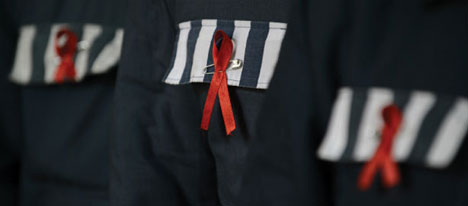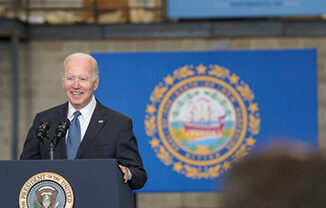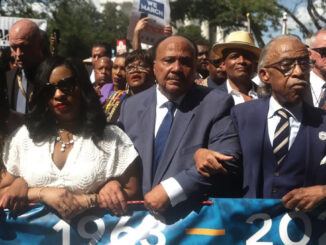

Young, gay, Black — and at risk for HIV
Government neglect and historic patterns of segregated living and socializing have helped fuel the epidemic among very young gay Black men.
By Staff Writer
Joshua Alexander was 19 when he found out he was HIV positive in 2006. He had gone to a health fair at the university he attended in Mississippi to get tested, completely unaware he might have the virus. In his mind, he was just doing what we tell people to do now — if you’re in a relationship, go get tested with your partner. Joshua’s boyfriend was a no-show.
Alexander’s story is disturbingly common among young African-American gay men. The Centers for Disease Control and Prevention released a study showing that one-quarter of all new HIV infections in 2010 were among adolescents and very young adults, with an estimated 1,000 new people between 13 and 24 years of age contracting the virus each month. And, in the study, 45 percent of newly infected men who have sex with men — the researchers don’t track sexual identity, but rather behavior — were Black. Other studies show that Black men 13-29 who have sex with men have the highest annual new infection rate of any subgroup in America.
It’s obvious what part of the problem is, says Cornelius Baker, a senior policy advisor with the National Black Gay Men’s Advocacy Coalition. “This data really highlights the need for better sexual health education in America’s schools, community health centers, and other healthcare settings that speak directly to the needs of sexual-minority youth,” he said. “Right now, young people are really abandoned to themselves for information.”
Getting an HIV diagnosis was unfortunately Alexander’s first real health education les-son. His school in Greenville, Miss., included almost nothing in its health curriculum about HIV, and even less about how to stay safe as a sexually active gay man.
“When the nurse who tested me came back with my results, she asked me to have a seat,” said Alexander, who is the subject of a new documentary about HIV/AIDS called Deep South. “But I told her ‘I’m going to stand because I know you’re gonna tell me I am negative and then I’m out of here.’”
Too often when we hear stories about people who have HIV, it is followed by a discussion of what they did to put themselves at risk. But for many young gay Black men, what they’ve done isn’t what is driving them to have the highest HIV rates in the country. Several studies show Black gay and bisexual men wear condoms more often than white men. But because they are coming of age sexually in a population that already has a high HIV prevalence, one slip-up creates a higher probability of infection. Many young gay Black men live and begin their sexual lives in a racially segregated world where HIV has had three decades to gain a foothold. Adding to the isolation, some research shows that other racial groups of gay men in the U.S. view Black men as the least desirable sexual partners, and there’s a great deal of data overall showing that African Americans remain more geo-graphically segregated than other groups, concentrated in heavily Black communities and counties around the country. Part of the pattern of segregation has to do with continuing impact of America’s racial history, but part is also current choice: many Black gay men say they do not want to live in the urban “gayborhoods” like Chicago’s
Boystown or New York’s Hell’s Kitchen, preferring instead to reside in predominantly Black neighborhoods. Racially segregated housing and dating contributes to the high concentration of HIV in communities given few resources to fight it.
Against this backdrop – and helping to create it — we have a public health system that has never focused major resources on HIV prevention efforts targeting Black men who have sex with men. Though the CDC funded some specific initiatives for Black gay men during the early years of the epidemic, the CDC only released a funding announcement for outside in intervention programs for young men of color in 1998 — 17 years into the epidemic. (I recall this because I was a young HIV educator in Cleve-land when the announcement was made, and it was clear even then that going on 20 years into the epidemic was far too late to be starting such efforts.)
There are other reasons for the higher HIV rate among Black men who have sex with men, as well. In a country where health insurance is largely employer-based, high rates of unemployment among Black men as a whole increase health disparities that promote risk of HIV, such as higher rates of untreated sexually transmitted infections that can help facilitate HIV acquisition. Thanks to their lower level of contact with the healthcare system, Black men are more likely to be get tested for HIV only when al-ready in advanced disease, so an HIV-positive test often accompanies a diagnosis of AIDS. And they are more likely to experience homelessness, which has been shown to be a major predictor of vulnerability to HIV infection, for a variety of reasons.
Given the particularly high rates of HIV among Black youth, the fact that we still spend $50 million federally on abstinence-only education programs should be a point of shame and disgrace for the world’s richest nation. These programs have been proven to be ineffective in delaying the sexual debut of teens, reducing teen pregnancy, and preventing HIV or other sexually transmitted infections.
Louisiana, where I live, is home to the cities that rank first and second in HIV infection rates in the nation — Baton Rouge and New Orleans, respectively — and still the legislature rejected a bill to allow for comprehensive sex education in the schools. Schools must use approved abstinence-based curricula; anything else is only optional under state law. Additionally, some Republican lawmakers recently rejected a bill to merely allow data to be collected about the sexual behaviors of teens in the state. If the Department of Education, under the leadership of Secretary Arne Duncan, continues to allow for this kind of political carelessness to go on at the state level, the country will continue to miss its best opportunity to reach many young people before it is too late.
The Affordable Care Act, which goes into effect in 2014, would in theory correct some of the disparity in access to care, by expanding Medicaid coverage, covering all people with HIV, and providing some funds for prevention education and care for a range of illness. Governor (and, some say, 2016 presidential hopeful) Bobby Jindal announced after the election that he would be rejecting the federal funding for the ACA’s Medicaid expansion. So it’s possible that states like mine that have high rates of HIV infection, particularly among Black residents, may not benefit from the ACA’s changes intended to reduce the burden of HIV.
Sadly, the only real national attention to HIV rates among Black men has been a decade-long obsession with men on the down-low (i.e. closeted bisexuals), which is absurd given that several studies have shown that bisexual men who don’t disclose their homosexual relations are less likely to have HIV than are out gay men. All of the news stories and television shows that focused on this issue wasted a lot of precious resources and time, and took focus from a real discussion about HIV epidemic among Blacks.
The first ever U.S. National HIV/AIDS Strategy, released in 2010, offers a good national framework for a coordination of efforts from the federal agencies that are responsible for health, housing, substance abuse and mental health treatment, prisons, labor, and education. But without resources, it will remain just that — a skeleton of a good idea. The need for dedicated federal, state, and local resources to be targeted at Black communities, and particularly at gay, bisexual, or transgender people within them, is critical.
Being part of the “AIDS-Free” Generation Hillary Clinton announced in June should be every Black gay young man’s right. Yet we have everything but the political will to make that a reality.
KENYON FARROW – Kenyon Farrow is a writer and public health advocate. He works for the Praxis Project, based in Washington, D.C.





Be the first to comment